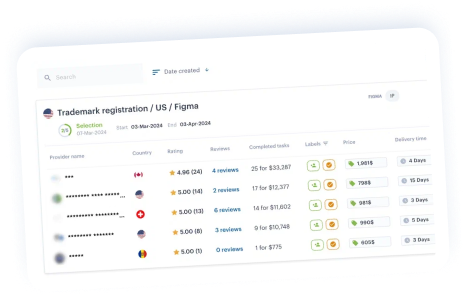Utility patents are a popular and effective way to protect inventions in the United States. Obtaining a utility patent can give the inventor the exclusive right to make, use, and sell their invention for up to 20 years.
However, the patent registration process can be complex and time-consuming, requiring careful attention to detail and knowledge of the legal requirements. This article will provide a utility patent definition and an overview of how to get a utility patent in the US.
Contents
2. What can and cannot be patented in the US?
3. What documents are required to register a utility patent in the US?
4. How long does it take to register a utility patent in the US?
5. What is an Information Disclosure Statement?
6. How much does a utility patent cost?
1. What is a utility patent?
A utility patent, or a patent for an invention, is the grant of a property right to the inventor issued by the USPTO. A utility patent example can be a new and innovative machine, such as a new type of engine, a medical device, or a manufacturing process.
How long does a utility patent last? The term of a new patent is 20 years from the application date or the earlier related application.
There are three types of patents:
- Utility patents may be granted to anyone who invents or discovers any new and useful process, machine, article of manufacture, or composition of matter or any new and useful improvement thereof;
- Design patents may be granted to anyone who invents a new, original, and ornamental design for an article of manufacture; and
- Plant patents may be granted to anyone who invents or discovers and asexually reproduces any distinct and new variety of plant.
Inventors may apply for one of two patent applications:
- A nonprovisional application, which begins the examination process and may lead to a patent, and
- A provisional application, which establishes a filing date but does not begin the examination process.
2. What can and cannot be patented in the US?
To qualify for patenting, the invention must be:
- Novel (In the USA, the novelty grace period is 12 months before the US filing date or before the priority date);
- Non-obvious;
- Adequately described or enabled (for one of ordinary skill in the art to make and use the invention);
- Claimed by the inventor in clear and definite terms.
What can be patented:
- Process
- Machine
- Article of manufacture
- Composition of matter
- Improvement of any of the above
- Laws of nature
- Physical phenomena
- Abstract ideas
- Literary, dramatic, musical, and artistic works (these can be Copyright protected)
- Inventions which are not useful (such as perpetual motion machines) or offensive to public morality
3. What documents are required to register a utility patent in the US?
A nonprovisional application for a patent should include:
- A written document that comprises a specification (description and claims);
- Drawings (when necessary);
- An oath or declaration;
- Payment of filing, search, and examination fees;
- Priority document (when necessary);
- Power of Attorney (when necessary).
The official language of the US patent application is English.
You must file the priority document within four months from the application date or 16 months from the prior foreign application.
4. How long does it take to register a utility patent in the US?
It takes an average of 32 months from filing to granting a patent in the USA.
The term for filing an application claiming priority of a provisional or conventional application is 12 months from the priority date.
After the expiration of the 12-month period, you can restore the right of priority if the delay in filing the subsequent application was unintentional. You must file the application claiming priority within two months of the expiration of the 12 months, and include a request and appropriate fee.
The time limit for the PCT national phase entry in the United States of America is 30 months from the priority date. The national stage can be revived if you file a petition and fees within two months.
5. What is an Information Disclosure Statement?
The applicant must provide an Information Disclosure Statement (IDS) containing any information that could affect the patentability of the claimed invention. This duty applies to the applicant’s legal representative and anyone involved in the application process.
The information can be of any type and includes, but is not limited to, prior art. The duty continues until a patent is issued or the application is abandoned. An intentional failure to submit an IDS may result in a later declaration of the patent as unenforceable.
If the IDS is filed within three months from the filing date or before the first office action, you don’t need to pay any government fee. If the applicant or their representative knew about information in an IDS over three months before filing or if a foreign patent office previously cited the information, you must pay extra fees.
6. How much does a utility patent cost?
Government fees of a utility patent registration in the US:
| Application: | |
|
320$ |
|
300$ |
|
480$ |
|
100$ |
|
860$ |
|
420$ |
|
420$ |
| Utility search fee | 700$ |
| Utility examination fee | 800$ |
| Utility issue fee | 1200$ |
| Maintenance: | |
|
2000$ |
|
3760$ |
|
7700$ |
As you can see, the final utility patent cost can be rather high. However, there are some discounts for small and micro businesses.
Fees for filing, searching, examining, issuing, appealing, and maintaining patent applications and patents are reduced by 60 percent for any small entity that qualifies for reduced fees under 37 CFR 1.27(a), and are reduced by 80 percent for any micro entity if the requirements under 37 CFR 1.29(a) or (d) are met.
The utility patent filing cost in the US via the iPNOTE platform starts from as low as $900, which includes all government fees and document preparation. Find the best patent agent in the US on iPNOTE.
7. Final thoughts
Obtaining a utility patent in the US can be a complex and time-consuming process, but it’s well worth the effort for inventors looking to protect their innovations. To ensure the accuracy and completeness of the patent application, it is advisable to seek the assistance of a qualified patent attorney. They can help you navigate the process and avoid common pitfalls, as well as provide advice on the strength and validity of your patent.
***
The iPNOTE platform features more than 700 IP law firms that cover more than 150 countries, so you can always find the right direct service provider using our flexible filtering system.
Take a look at our directory of providers in the US.
Sign up for free, and we’ll help you solve any IP problem.
Elevate your digital presence with our cutting-edge application design. Explore the latest trends and innovations with our industrial design online platform.







